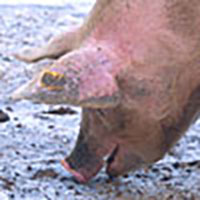Swine Flu (Swine Influenza)
Swine flu received high publicity following an initial outbreak of swine flu in Mexico & the US between late March and April 2009.

What is swine flu?
Swine flu is a respiratory disease which usually affects pigs (swine).
Swine flu is also known as swine influenza. H1N1 a form of type A influenza virus is the virus which causes swine flu.
In humans, the symptoms of swine flu are similar to those of seasonal influenza (common flu) however the outcome in some cases can be fatal (swine flu prognosis).
For a full list of symptoms, see 'Swine Flu Symptoms'.
As swine flu is caused by a virus, there is no cure once it takes hold in the body. The focus is on preventing swine flu.
Swine Flu Transmission
H1N1, the type A influenza virus which causes swine flu can mutate into a form which is transmittable to humans.
Airborne Transmission
As an airborne virus, swine flu can infect a person who breathes in moisture droplets from the air which carry the virus.
Highly contagious, swine flu can easily be transmitted to people who are in close proximity to an infected person. It is thought that for a person to catch airborne swine flu directly from an infected person, they would need to be within a few feet of them.
Surface Contact Transmission
Swine flu can also be transmitted through a person touching a surface with the flu virus on it and then touching their nose or mouth.
The length of time a flu virus can survive whilst on the surface of an object will vary with levels of humidity, sunlight and temperature. According to the Centre of Disease Control (CDC), some viruses and bacteria can survive for over two hours on a surface. As there is little research on the current strain of swine flu, the survival time of the virus on surfaces is not yet known.
The incubation of most flu viruses is around 3-5 days – it is unclear whether the 2009 strain has a similar incubation period although at present there is no reason to think otherwise.
Transmission Through Food?
Swine flu virus is not transmitted through food. You cannot get swine flu by eating pork or pork products such as sausages.
Swine Flu Prognosis
The severity of swine flu in humans can range from mild to severe. In its most severe form, death is a possible outcome. With the 2009 outbreak fatalities have only happened in Mexico suggesting that there are environmental factors at play which can increase the severity of this condition.
Despite a significant number of cases in the US, the majority of swine flu symptoms have been mild.
With swine flu the emphasis is on recognizing the symptoms early so appropriate treatment can be taken. By diagnosing early stage swine flu, steps can be also be taken to reduce the spread of this contagious disease.
Swine Flu Statistics
Before the 2009 outbreak, it was thought transmission of the swine flu virus was limited between humans.
Statistics of swine flu from the Center of Disease Control (CDC) show that between 2005 and early 2009, only 12 human cases of swine flu were detected in the US. None of these cases were fatal.
Until recently swine flu was not considered to be a particularly devastating disease although fatalities have occurred on occasion. During 1988, a woman from the US state of Wisconsin died from swine flu only 8 days after being initially hospitalized for pneumonia.
Swine Flu History
During the 20th century, the most serious outbreak of swine flu in the US occurred during 1976. In Fort Dix, New Jersey a swine flu outbreak affected more than 200 people causing serious illness in several and one death.